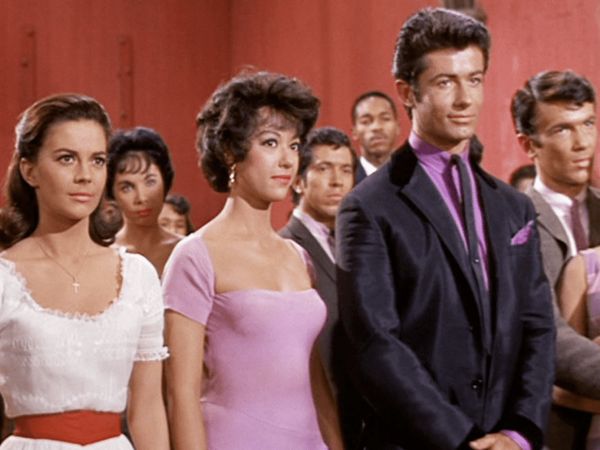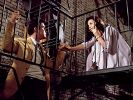Eye For Film >> Movies >> West Side Story (1961) Film Review

A tale already borrowed, West Side Story is nearly the 50th version of Romeo and Juliet to be filmed. If that constitutes a spoiler then so be it, the joy of this and many versions is not the direction of travel but how it gets there. With the benefit of distance, the demands upon a filmed version of West Side Story were not trivial, even when one considers that this is the work that made reputations.
It was Stephen Sondheim's Broadway debut, Leonard Bernstein's return to commercial success after Candide, Jerome Robbins was fresh from film success with The King And I and would produce Gypsy in the gap between West Side Story's stage and screen versions. Arthur Laurents had written the 'book' for West Side Story, in a career that had already seen him adapt Rope for American screens. Ernest Lehner had a Hitchcock connection too, North By Northwest was one of his. All giants, but who at the time could have seen where they'd go?

There are two credited directors, it seems as if Robbins re-directed the musical and Robert Wise directed the film around it. Robbins was bumped near the end as the film went over budget and schedule but retained credit. There are points where the film leverages cinematic perspectives (one spiraling staircase after revelation) that are far from stage. In others, particularly the song America, the rooftop setting feels even more enclosing and static than any theatre. In places it is abstractly impressionistic, if not expressionistic - the black chimneys of the tenements stark against the red sunset that heralds Tonight, the dividing lights and intervening bars of Somewhere. Wise had a reputation as, if not a safe pair of hands, then a frugal and prepared director. He would share an Oscar with Robbins for West Side Story, in a slew of film awards that outstrip its Tonys by ten to two. That contemporary recognition isn't undeserved, but 'contemporary' does a lot of lifting. It is very much of its era.
The ethics and mechanisms of its portrayal of New York's Puerto Rican community have inspired, and will yet, pages of discussion. While at its heart is a story so simple that even Shakespeare stole it, the politics of it all aren't just complicated by the number of run-ins those behind the camera had with the House Un-American Affairs Committee. Among the black-face and black-lists are any number of other colours. With the benefit of 60 years of hindsight of course a lot of it looks dated, but the elements of history and futurity are as battered and bruised as the Sharks and Jets after their rumble.
It still does things that surprise. To see the cast stare down the camera, staring up? That grabs in a way even now, in a way even a flourish on the boards and in the limelight can't. The glint of light on a fateful switchblade is brighter than could be managed by any spot operator, more certain of attention than any seat no matter how it's marked for restricted view or limited leg-room on the chart. The multicoloured transition from Maria twirling in her dress to the gymnasium and its mambo remains a treat, and however filmic it might be there's a lot of choreography in it and that's all got its roots in Jerome Robbins' work with the stage production. The blur when Tony and Maria first see each other remains amazing. The set doesn't quite empty, but our focus changes with theirs. While Spielberg traded this for removing them to under the bleachers in his version, it's not hard to see why. Even knowing that it's coming, I still suspect something has gone wrong. One supposes that, at the level of the fates, it has, but that kind of trick requires a different level of sophistication from audiences. The original Manchurian Candidate had a sequence out of focus by accident, but it works. I'm not sure all modern viewers would be as forgiving, the McLuhan boundaries between medium and message drift.
Filmed versions of musicals could attract audiences their live counterparts never could. Never mind the difference between maybe $5 a ticket (and getting to New York!) and 75 cents or so, even across several reels a matinee wouldn't wear out the cast in the same way. Wise would go on to do The Sound of Music and with this start constructing a cyclical relationship between stage and screen musicals. Revivals could leverage fanbases that had grown with film in ways no quantity of cast recordings and touring productions ever could. That the economics and creative borrowings involved would give us both an unrealised Spider-man musical and inform both Burton's Bat-man and some of the latter Bats out of Hell is a rabbithole for another day.
Natalie Wood's Maria, Richard Beymer's Tony, remain defining performances within the roles. It reorders songs from the stage show, in part because of the differing demands of intermissions. It is perhaps easier to understand the musicals of the era because they haven't much changed, but how cinemagoing has changed in the interim is much more profound. Not just inflation, technology, the mechanisms of distribution, accessibility. Watching West Side Story on a colour television with the ability to pause, and skip, to make those two and a half hours fit my schedule? Not, in truth, that one needs to unless real life intrudes. It still grabs, entertains, and while it's almost impossible to consider as an entity of itself rather than also an artefact of a time and a place that last gives it new power.
There are oddities of circumstance. Knowing that Wise had helmed the (tedious) Star Trek: The Motion Picture I noticed a similarity between the melancholy instrumental reprise of Somewhere and that boldly going theme. That's likely got more to do with the tendency in orchestration to the string and my ears than anything else, but gives me grounds for an interesting fact. Star Trek was never the most highly rated television show, indeed it languished in the ratings. What gave it strength, beyond the advocacy of Lucille Bull, was that its broadcaster NBC was owned by General Electric who made colour televisions. Star Trek was not only the most highly-rated colour television show, but drove adoption, at least in the US. It's those bits of background that make history, and it's those details that make things interesting. West Side Story retains both of those.
The littlest touches, like the diegetic elements of the end credits, graffito scrawls on traffic signs and walls. The sense of heat and claustrophobia engendered by the sets, that descent to ground level is a steep on after the airy aerial footage that opens it. It still inspires too. It's much harder to draw a line between this as an adaptation from the original stage play. The proximity of those involved, including sharing a director with the Broadway run, complicate this further. The extent to which filmmaking technology and technique have advanced since then is too large to summarise. Wise was one of the first to use a helicopter shot, while The Sound of Music was by a long way not the first to have footage from a helicopter (that honour goes to 1945's Bandit Of Sherwood Forest) it was one of the first to use a full-size camera and not an Arri handheld. It also established a vocabulary of them as an extension of dolly and boom zooms. Along with editing, camera movement is one of the elements almost unique to film, and West Side Story displays both in quantity. That film as a medium is sixty years older is palpable, however, and that's one of the strengths of Spielberg's revival.
In one of the DVD features, Arthur Laurents says that they were more concerned with being good than being successful. As a stageplay, and, absolutely as a film musical, West Side Story more than achieves both. While it has aged in places, if anything as a source of discomfort it adds to the unease that it is seeking to create. In a huge cast there are dozens of familiar faces, behind the screen are some half dozen near household-names. These each matter less than that, even at this remove, it sets feet to tapping and fingers to snapping.
Reviewed on: 27 Jan 2022















